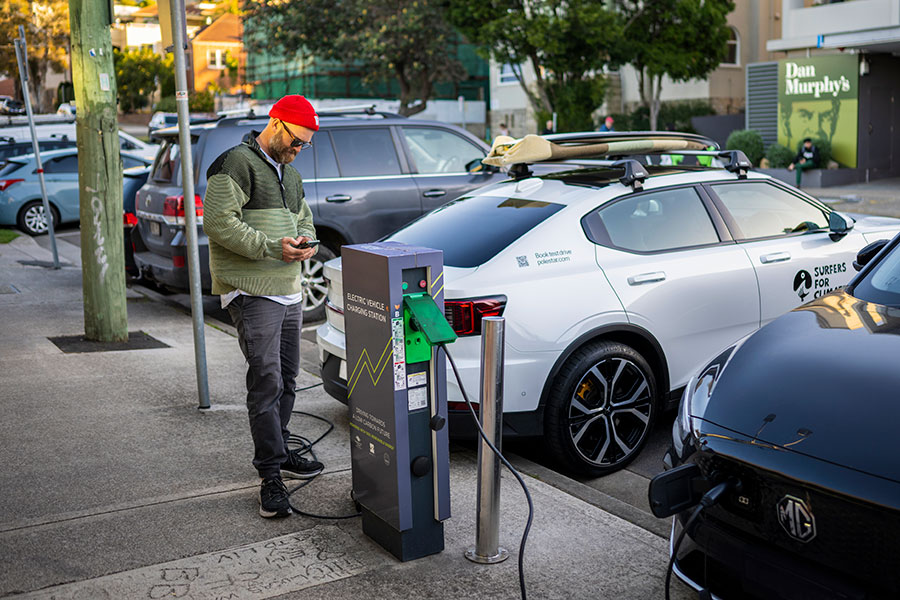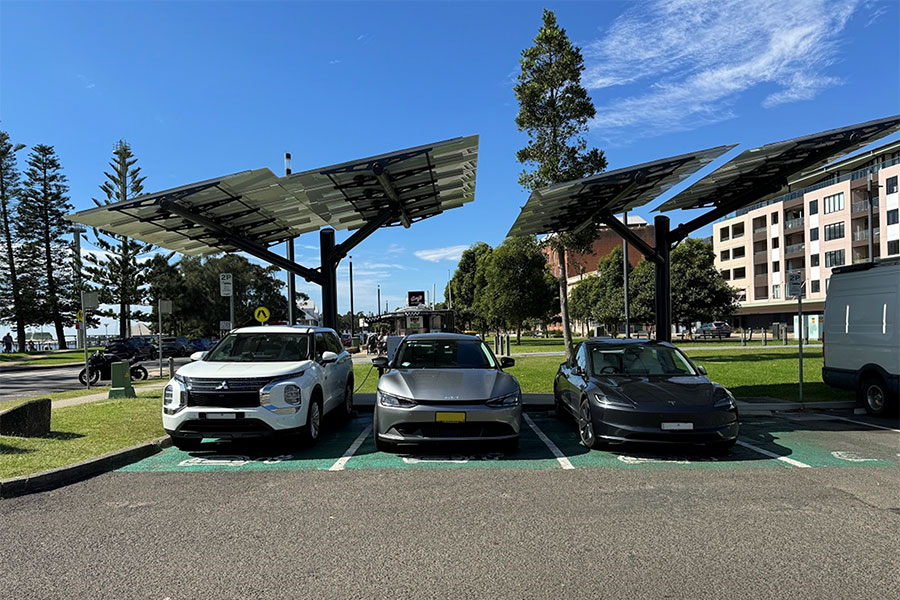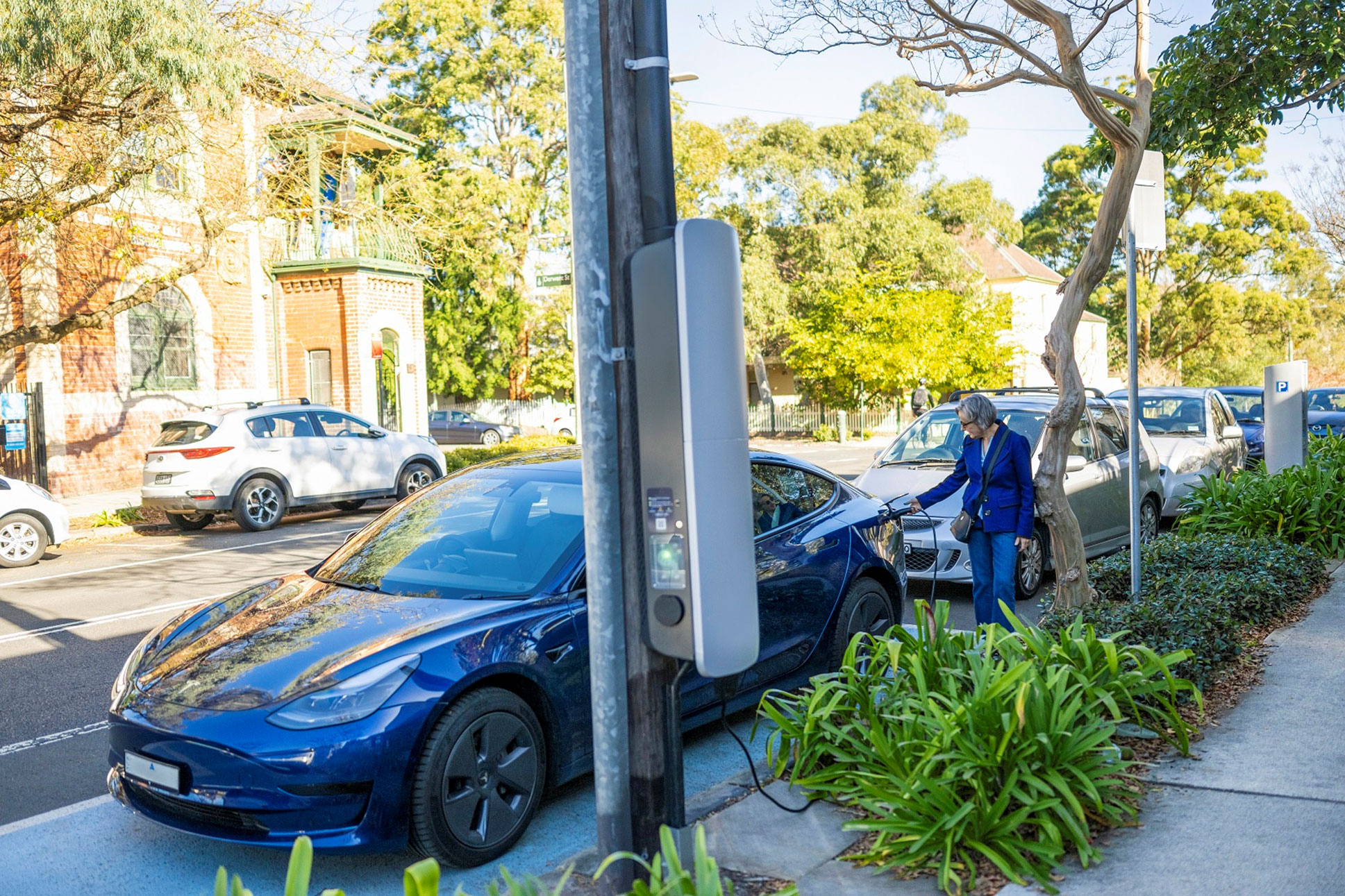Case studies
EVC unit on the road verge
A local council has noticed that there is increasing use of electric vehicles and they wish to make it easier for residents to charge them. To do this, council proposes to install an EVC unit on a footpath near a kerb of a council road in an employment zone, within their local government area.
Since council is a public authority under the EP&A Act, this EVC unit can be installed by council as development without consent under section 2.124 of the T&I SEPP, if it meets the listed development standards. For example, the EVC unit must:
- be installed at least 30 cm behind the face of the kerb
- comply with the relevant Australian standards for electrical installations and equipment
- not obstruct not obstruct access to, or interfere with, firefighting structures such as a fire hydrant.
Installing the EVC unit will involve erection of a structure on a public road, which means that consent and sometimes concurrence is required under the Roads Act. However, the road is a local road managed by council, so it is also the roads authority. This means council does not need to seek consent or concurrence under section 138 of the Roads Act from TfNSW. The EVC unit can contain advertising if council chooses, as it is not located in a residential zone.
EVC unit in a car park
A supermarket wishes to attract electric vehicle users to their business. To do this, they wish to install an EVC unit adjacent to a parking space within their own private car park that is associated with the supermarket. They also wish to include advertising on the EVC unit to provide extra revenue.
This EVC unit is able to be installed as exempt development under section 2.124D of the T&I SEPP, if it meets the listed development standards. For example the EVC unit must:
- comply with general exempt development requirements in section 2.20 of the T&I SEPP
- comply with the relevant Australian standards for electrical installations and equipment
- not extend onto or above a public road.
Since the EVC unit includes advertising, it would also need to meet the relevant additional development standards.
EVC unit on an existing lighting pole
A private developer wishes to install an EVC unit and associated advertisement on an existing power pole. The power pole is owned by an electricity supply authority that built the pole.
This EVC unit is able to be installed as exempt development under section 2.124E of the T&I SEPP, if it meets the listed development standards. For example the EVC unit must:
- comply with general exempt development requirements in section 2.20 of the T&I SEPP
- not contain batteries capable of storing a total of more than 1kWh of energy
- fully contain charging cables when not in use.
Since the EVC unit includes advertising, it would also need to meet the relevant additional development standards, and not be in a residential zone.
Since the private proponent does not own the power pole, they will need to obtain approval from the asset owner before installation can occur.
Frequently asked questions
Demand for electric vehicles is increasing as people embrace emerging technologies and cleaner energy options. Under the NSW Electric Vehicle Strategy (2021), electric vehicle sales are expected to increase to 52% by 2030–31. This demand has also increased the requirement for electric vehicle charging units (EVC units). Therefore, more of them are needed in appropriate and convenient locations across the state.
The proposed changes will make it easier to build charging facilities through a streamlined approval process. Providing a clear path through the approval process encourages more investment in charging locations.
The planning approval pathways for EVC units can be found in the State Environmental Planning Policy (Transport and Infrastructure) 2021 (T&I SEPP). Depending on the scale or location of the EVC unit, the T&I SEPP provides three different planning approval pathways:
- Exempt development: Relates to very low-impact development. If proposed works meet all development standards identified in the T&I SEPP, planning approval is not needed from council.
- Development without consent: Applies to activities, generally done by public authorities that are government agencies, or private bodies deemed to be public authorities. A Minister or public authority can only approve these activities following an environmental assessment under Division 5.1 of the Environmental Planning and Assessment Act 1979 (EP&A Act).
- Development with consent: Refers to development that will need planning approval from a consent authority, typically from council.
EVC units can be installed as exempt development under section 2.124D, section 2.124E and section 2.124F of the T&I SEPP.
EVC units are exempt development where installed in or on:
- private homes
- bus depots
- car parks (commercial, public or private)
- car washing facilities
- highway service centres
- on public administration buildings
- road maintenance depots
- service stations
- existing electricity poles
- existing light poles.
Public authorities can also install an EVC unit as exempt development on existing street furniture, including:
- parking meters
- telephone booths
- rubbish bins or recycling bins
- planter boxes
- street signs
- benches
- bollards.
The development standards that must be fully satisfied before installing an EVC unit as exempt development are also set out in T&I SEPP. This includes complying with the general requirements for exempt development in section 2.20. If the proposal does not satisfy these standards, another approval pathway must be used, such as seeking consent via a development application.
Development standards are criteria that manage the impacts of the installation. For instance, all EVC units developed as exempt development must be installed according to manufacturer specifications and comply with relevant Australian Standards.
Public authorities and electricity supply authorities can install EVC units in certain circumstances without development consent on land they own or control under section 2.124 of the T&I SEPP.
If this pathways is used, public authorities will need to assess the activity under Division 5.1 of the EP&A Act before carrying it out. This allows new EVC units to be assessed in a way that will lead to better development outcomes. For more information on this assessment process, see the Guidelines for Division 5.1 assessments (PDF, 2.9 MB).
EVC units can be installed as development with consent under section 2.124A, section 2.124B and section 2.124C of the T&I SEPP.
Section 2.124A allows EVC units to be developed on any land, if they do not obstruct movement or interfere with firefighting equipment. An EVC unit with advertising can also be approved through development consent under this section.
When a homeowner or occupier does not have access to a private garage or carport and is required to park on the street, the development with consent planning pathway allows homeowners or occupiers to install an EVC unit on public land. Section 2.124B allows homeowners or occupiers to submit a development application to council to install an EVC unit on public land as long as the electrical power is connected to the residential dwelling and the cables are located underground. Section 2.124C allows EVC units to be installed in a wide variety of zones or on land on which there is an existing service station, highway service centre or car washing facility.
Yes, there are development standards in the T&I SEPP for development with consent and development without consent planning pathways. These requirements must be met for each planning pathway to be used for a proposed EVC unit.
Advertising on EVC units, including a screen or other displays capable of displaying advertisements, is permitted in some circumstances. This includes the advertisement itself, not just the display.
For EVC units with advertisements to be exempt development:
- the development must comply with section 2.20
- the sign must be fully contained within the unit
- the sign must not have a surface area greater than 3 m2
- the sign must comply with AS/NZS 4282:2019, Control of the obtrusive effects of outdoor lighting
- if the sign is illuminated—it must not be animated, flashing or moving.
While each display (or screen) must not have a surface area greater than 3 m2, there is no restriction on the number of displays. This means, an EVC unit may have multiple displays, if each display is no greater than 3 m2.
Advertising on an EVC unit can only be located where the associated EVC unit is allowed as exempt development, for instance in a car park or service station, or attached to street furniture.
Advertising on an EVC unit can also be approved under the development without consent (section 2.124 of the T&I SEPP) and development with consent (section 2.124A and section 2.124C of the T&I SEPP) pathways. If a proposal does not meet the required standards for either exempt development or development without consent, consent will be required.
For amenity reasons, advertising on EVC units is not permitted in any residential zones – regardless of the planning pathway.
The T&I SEPP does not provide development standards for advertising in an EVC unit that can be approved as development with consent. Councils may have their own development standards they apply during their assessment of proposals. Anyone seeking to install an EVC unit with advertising through the development with consent planning pathway should first consult council
You must comply with any existing condition of the most recent development consent that applies to the premises. For instance, some development consents specify a minimum number of parking spaces that must be provided for residents and visitor parking. Building owners should consult their council to determine if an existing car space that will be used only for electric vehicle charging breaches any conditions of an existing development consent.
In addition to the requirements under the EP&A Act, there are also obligations under other legislation.
Where works are proposed within the road reserve, including the footpath, consent of the appropriate road authority is required under section 138 of the Roads Act. Work within the road reserve may include activities like erecting an EVC unit or interfering with a structure. The relevant local council is the roads authority for much of the land where EVC units could be located.
For classified roads the Roads Act provides that:
- consent may not be granted except with the concurrence of Transport for NSW (TfNSW)
- if the applicant is a public authority and the roads authority, TfNSW must consult with the applicant before deciding whether or not to grant consent or concurrence.
An approval under section 138 of the Roads Act does not imply that development consent is granted under the EP&A Act. Where works are exempt development under the T&I SEPP and do not require approval under the EP&A Act, this does not affect any requirement to obtain approvals under the Roads Act or any other Act.
The Local Government Act may also impose requirements on proposals for EVC units, such as approval from council for certain activities. It is recommended that anyone seeking to install EVC unit on council owned or managed land should consult council first.
We encourage you to engage a professional town planner or seek legal advice as required to help you ensure your proposal meets all applicable legislative requirements.
These frequently asked questions and case studies provide general guidance only. Reference should be made to NSW Legislation to confirm current NSW legislative requirements.
More information
For more information, phone the Planning Customer Support Team on 1300 420 596 or email [email protected]


